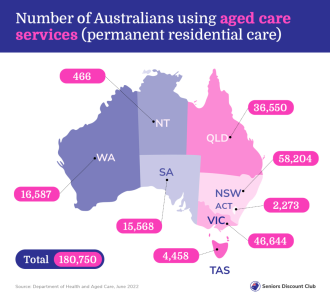Proposed new national guidelines aim to make aged care facilities feel like home
- Replies 13
We here at the SDC love to read about innovation, especially when it's in a field that's close to our hearts, such as aged care.
Thankfully, the Australian Federal Government is doing a lot of work to revolutionise the industry and make sure that those who require this kind of assistance can look forward to a happy and healthy retirement.
Recently, the Federal Government released a new draft of aged care design guidelines with the intent of transforming aged care institutions from bustling facilities into warm and inviting homes.
According to a report by the Royal Commission, these guidelines are set to become the gold standard for all future builds and refurbishments of aged care residences.

Central to the guidelines is the principle that residents live in small households of fewer than 15 in order to foster a sense of community.
This concept is already being tested and rolled out by organisations like HammondCare, which has implemented a 'cottage' care model at several locations across Australia, including their facility in Miranda Campus in Southern Sydney.
Pauline Matthews, 92, moved to the campus along with her husband, John, and has nothing but praise for the new arrangement. 'If you need to be somewhere, not your own home, you couldn't be anywhere better,' she said.
'You've got full independence, yet you've got someone to look after you all the time if you need it. The food's lovely, the staff are lovely.'
If you ever visit one of the residences that operate with these new guidelines, one of the first things you'll notice is how natural the setting looks and feels. Because of the design, all of the equipment required for clinical care is hidden behind closed doors in order to maintain the 'at-home' feeling of the facility.
The kitchens are also completely different to what you'd find in a traditional aged care facility. Rather than having a separate industrial-sized kitchen located elsewhere, with food being cooked in bulk and distributed, the guidelines recommend positioning the kitchen as the literal and metaphorical centre of the house.
At HammondCare's Miranda residence, for example, there's a kitchen right at the heart of the building that can be used by staff members to prepare meals and which residents are also welcome to use if they'd like to pitch in and show off their cooking skills.
'I love cooking, and I innovate,' said 87-year-old Warren Wearne.
'My mother and father had eight kids. They made every one of us learn to cook.'
The guidelines also include dementia-friendly design principles, such as short corridors, contrasting colours and colour-coded taps.
HammondCare's General Manager of Residential Care and Dementia Care, Angela Raguz, said: 'There are no dead ends and minimal locked doors,' making the accommodation easier to navigate for those with cognitive impairments.
Beyond physical features, there are also steps taken to make the rooms more recognisable, such as memory boxes that can be filled with personal items, allowing residents to identify their beds and possessions easily.
The deadline for the design guidelines, set by the Royal Commission, was at the beginning of this financial year, and the public is now invited to provide feedback and suggestions. It is expected that the guidelines will be implemented in July of next year.
Additionally, Craig Gear from the Older Persons Advocacy Network suggested that it would be beneficial to introduce some form of incentive for providers who adhere to the rules.
He proposed the possibility of seed funding or star ratings as potential ways to both reward those who are following the guidelines and encourage others to embrace the changes.
Gear added, 'Having the right design building is also about training staff in the right way. Training staff in behaviour support in dementia is absolutely essential as we move forward with reforming aged care.'

Members, how do you feel about the new national guidelines? Have any of you had personal experiences with aged care facilities? We would love to hear your stories, so please feel free to share them in the comments below.
And always remember, if you or someone you know is facing challenges related to aged care or simply seeking more information, don't hesitate to reach out. You can call the Older Persons Advocacy Network at 1800 700 600 or visit their website at opan.org.au for assistance and guidance.
Thankfully, the Australian Federal Government is doing a lot of work to revolutionise the industry and make sure that those who require this kind of assistance can look forward to a happy and healthy retirement.
Recently, the Federal Government released a new draft of aged care design guidelines with the intent of transforming aged care institutions from bustling facilities into warm and inviting homes.
According to a report by the Royal Commission, these guidelines are set to become the gold standard for all future builds and refurbishments of aged care residences.

New draft aged care design guidelines from the Federal Government aim to turn institutions into homes. Credit: Shutterstock.
Central to the guidelines is the principle that residents live in small households of fewer than 15 in order to foster a sense of community.
This concept is already being tested and rolled out by organisations like HammondCare, which has implemented a 'cottage' care model at several locations across Australia, including their facility in Miranda Campus in Southern Sydney.
Pauline Matthews, 92, moved to the campus along with her husband, John, and has nothing but praise for the new arrangement. 'If you need to be somewhere, not your own home, you couldn't be anywhere better,' she said.
'You've got full independence, yet you've got someone to look after you all the time if you need it. The food's lovely, the staff are lovely.'
If you ever visit one of the residences that operate with these new guidelines, one of the first things you'll notice is how natural the setting looks and feels. Because of the design, all of the equipment required for clinical care is hidden behind closed doors in order to maintain the 'at-home' feeling of the facility.
The kitchens are also completely different to what you'd find in a traditional aged care facility. Rather than having a separate industrial-sized kitchen located elsewhere, with food being cooked in bulk and distributed, the guidelines recommend positioning the kitchen as the literal and metaphorical centre of the house.
At HammondCare's Miranda residence, for example, there's a kitchen right at the heart of the building that can be used by staff members to prepare meals and which residents are also welcome to use if they'd like to pitch in and show off their cooking skills.
'I love cooking, and I innovate,' said 87-year-old Warren Wearne.
'My mother and father had eight kids. They made every one of us learn to cook.'
The guidelines also include dementia-friendly design principles, such as short corridors, contrasting colours and colour-coded taps.
HammondCare's General Manager of Residential Care and Dementia Care, Angela Raguz, said: 'There are no dead ends and minimal locked doors,' making the accommodation easier to navigate for those with cognitive impairments.
Beyond physical features, there are also steps taken to make the rooms more recognisable, such as memory boxes that can be filled with personal items, allowing residents to identify their beds and possessions easily.
The deadline for the design guidelines, set by the Royal Commission, was at the beginning of this financial year, and the public is now invited to provide feedback and suggestions. It is expected that the guidelines will be implemented in July of next year.
Additionally, Craig Gear from the Older Persons Advocacy Network suggested that it would be beneficial to introduce some form of incentive for providers who adhere to the rules.
He proposed the possibility of seed funding or star ratings as potential ways to both reward those who are following the guidelines and encourage others to embrace the changes.
Gear added, 'Having the right design building is also about training staff in the right way. Training staff in behaviour support in dementia is absolutely essential as we move forward with reforming aged care.'
Key Takeaways
- The Federal Government has released a new draft of aged care design guidelines that aims to transform institutions into homes.
- The guidelines will set the gold standard for future residential aged care builds or refurbishments and are based on recommendations from the Royal Commission.
- Central to the guidelines is the principle that residents live in small households of less than 15 in order to foster a sense of community.
- HammondCare has been implementing a 'cottage' care model that aligns with the design guidelines, offering small residential communities and dementia-friendly designs.
Members, how do you feel about the new national guidelines? Have any of you had personal experiences with aged care facilities? We would love to hear your stories, so please feel free to share them in the comments below.
And always remember, if you or someone you know is facing challenges related to aged care or simply seeking more information, don't hesitate to reach out. You can call the Older Persons Advocacy Network at 1800 700 600 or visit their website at opan.org.au for assistance and guidance.








